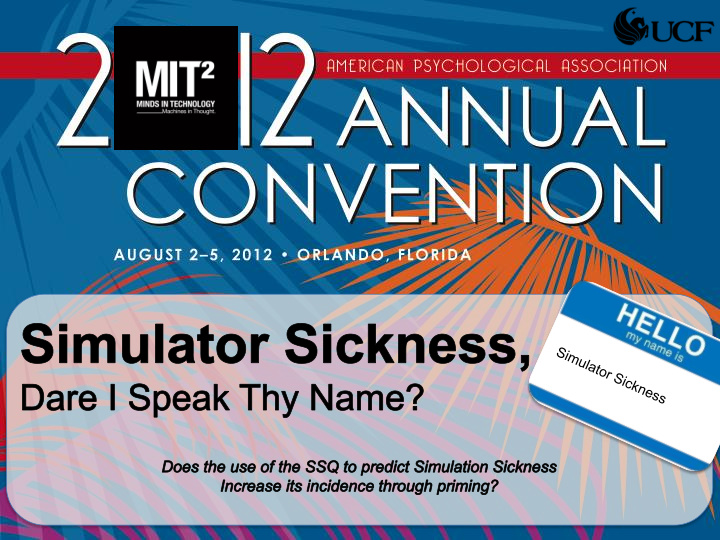



What is Simulator Sickness? • The report of illness or associated with the use of simulation devices • Similar to, but NOT motion sickness • Symptoms include – Eye strain – Vertigo – Headache – Sweating – Postural Instability – Nausea – Vomiting – Sweating – Disorientation
What is Simulator Sickness? • Is it… – a mismatch between a visual illusion and equilibrioception lack of illusion of movement? – a false positive poison response?
Why Do We Care? • It’s common: • Half of Pilots in Flight Sims (Kolasinski,1995) • Half of Undergrads playing Halo (Merhi, 2007) BUT Cybersickness != Sim Sickness (Stanney et al, 1997)
Why Do We Care? • Training “ The revelation has been put forward in Germany as a reason for the 42 year- old’s disappointing performances on his return to the sport in 2010 after a three- year hiatus. The theory is that Schumacher’s team mate Nico Rosberg, a young buck at 25 and one of the so- called ‘Playstation Generation’, can spend hours on Mercedes’ simulator with no ill-effects while Schumacher arrives at races ill-prepared and has to begin with a basic set-up. A team statement read “Throughout his career, Michael from time to time has been susceptible to simulator sickness which has affected the length of time that he can spend on a simulator,” read a team statement. “This is a relatively common occurrence for many people in all fields of simulator activity including military, aircraft and racing cars.” (Telegraph.co.uk, 2011)
Why Do We Care? • A Future Full of Simulation & Teleoperation
Why Do We Care? • Confounds for Researchers? • Yes (Bittner, Gore & Hooey, 1997, Casali, 1986) • No (Rizzo et al, 2003)
Why Do We Care? • Lost Participants: – Current UCF Poll: 15-25 % • Systematic trends of loss: – More discomfort in women (Mourant & Thattacherry, 2000) – More discomfort in novice drivers (Bedard et al, 2010) • Cleaning the simulator: – Enough said
How Do We Detect Simulator Sickness? • Simulator Sickness Questionnaire (SSQ; Kennedy et al., 1993) – A Laundry List of Symptoms
Wait… What About Priming? • Priming – exposure to a stimulus influences a response to a later stimulus (Neely, 2003) • Words associated with an elderly stereotype slow down the rate at which participants walk to an elevator upon leaving the laboratory (Bargh, Chen, & Burrows, 1996)
Totally Irrelevant
Wait… What About Priming?
Wait… What About Priming? Is the SSQ priming the symptoms it tests?
The Setup • Hypothesis • Method – Built on top of existing – Ss in the Max research condition will have – 2 Conditions between higher rates of Ss Simulation Sickness – Manipulated presence symptomology, as of pre-SSQ, Detail of measured by the Warning & Check-up post SSQ, than Min. Max Sim Sick Min Sim Sick Pre SSQ - Detailed Warning Minimal Warning Between Trial Check - Post SSQ Post SSQ
The Setup • Participants • Undergraduate students at a large southeastern university • N=33 (Max= 17, Min= 16) • Apparatus • Five driving tasks in a GE iSim PatrolSim fixed platform driving simulator
The Setup • Procedure • Informed consent and brief overview of the study • Forewarned • Description of simulator sickness • Pre-SSQ • 5 driving tasks » In between each drive, they were asked how they were feeling • Post-SSQ • Not forewarned • Told that simulator sickness is possible • 5 driving tasks • Post-SSQ
The Payoff • Results SSQ Composite Score • Participants in the forewarned condition (M=11.22, SD= 21.89) reported lower levels of sickness and fewer symptoms than participants who were not forewarned (M= 27.58, SD= 21.45), t(33)= 2.23, p=0.03.
The Payoff • Hypothesis was not supported • BUT Participants who were not forewarned actually reported higher levels of sickness than those who were forewarned
But Why!
But Why! • Participants • Undergraduate students at a large southeastern university • N=33 (Max= 17, Min= 16) • Apparatus • Five driving tasks in a GE iSim PatrolSim fixed platform driving simulator • Procedure • Informed consent and brief overview of the study • Forewarned • Description of simulator sickness • Pre-SSQ • 5 driving tasks » In between each drive, they were asked how they were feeling • Post-SSQ • Not forewarned • Told that simulator sickness is possible • 5 driving tasks • Post-SSQ
But Why! • Why did this occur? » In between each drive, they were asked how they were feeling • By reassuring the researcher (and thus, themselves) they were fine, they were priming themselves • Demand characteristics? • Cognitive dissonance? • Rehearsal? • This may yet be priming…
The Future (is now) Max Sim Sick 2SSQ Min Sim Sick Pre SSQ Pre SSQ - Detailed Warning Minimal Warning Minimal Warning Between Trial Check - - Post SSQ Post SSQ Post SSQ
Recommend
More recommend